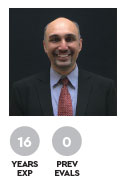DIRECTA DENTAL
Luxator P-series
Coated with titanium nitride for durability, the thin periotome tips efficiently cut the periodontal ligament before extraction
Although patients are never delighted to have a tooth extracted, certain techniques and instruments can be used during the extraction process to lessen the trauma and enhance the experience for both the patient and clinician. With an extremely sharp blade, a penlike grip, and an overall ergonomic design to make extractions easier, the Luxator P-series periotomes from Directa Dental efficiently cut the periodontal ligament before extraction. Comprised of 4 different configurations for all types of clinical situations, the Luxator P-series instruments allow dentists to perform extractions less traumatically, according to Directa Dental and confirmed by Dr. Daniel Quon, an oral surgeon who participated in this DPS evaluation.
“The Luxator P-series offers a simple way to make routine extractions easier,” Dr. Quon shared. “The blades on the instruments are extremely sharp and thin, allowing easy access into the PDL spaces. The extremely lightweight instruments are manufactured by a company that has a good track record in instrument design and technology. This is a well thought-out system of locators that make routine extractions less traumatic for the patient and operator,” he added.
Blade Design
The blades of the Luxator P-series periotomes are thinner and sharper than the original Luxator to precisely cut the periodontal ligament axially before the final extraction is made with a forceps or elevator. The tips are coated with titanium nitride for durability and do not need sharpening. The colorcoded Luxator P-series features the P1 with a straight blade, the P2 with an inverted curved blade, the P3 with a contra angle, and the dual-edged P4.
Calling the Luxator P-series a “phenomenal product,” Dr. Stuart Zaller noted, “The thinness of the luxators is remarkable.” Dr. Michael LaMarche would like to see a thinner blade for better access around the periodontal ligament space, while Dr. Elaine Gantz shared, “The sharpness of the blades and small size made them very easy to use.” When removing teeth, especially broken teeth and roots, Dr. Thomas Gilbert said it’s important to be as careful as possible to retain the bone. “The luxators had such thin tips that they literally slid down next to the root/tooth surface to get a good pivot point to luxate the tooth to loosen it,” he said. “It is the perfect solution to those tough extractions with broken roots or atraumatic extractions for implant placement.”
Ergonomics of Instruments
Shaped like a pen with an ergonomic grip, each instrument in the Luxator P-series is lightweight and user-friendly for maximum comfort, tactility, access, and control. “The ergonomic grip of the handles is very comfortable and helpful when exerting apical pressure around the roots of hopeless teeth,” shared Dr. LaMarche. “The great grip allows for more hand control and application of safely increasing apical pressure,” he added. Praising the ergonomics in the handle design and “the thin sizes to work around all quadrants of the mouth,” Dr. Andrew Chen said it was easy to control the force needed to luxate around the tooth. Dr. Mazhar Alhadid called the instruments lightweight, easy to grip, and extremely effective in severing the PDL. Praising the pen-like grip, Nader Zanzi, DMD, said, “Its superior grip resulted in greater control and leverage. I’m asking my assistants to make this part of our oral surgery setup more often.”
“The Luxator P-series offers a simple way to make routine extractions easier,” Dr. Quon shared. “The blades on the instruments are extremely sharp and thin, allowing easy access into the PDL spaces. The extremely lightweight instruments are manufactured by a company that has a good track record in instrument design and technology. This is a well thought-out system of locators that make routine extractions less traumatic for the patient and operator,” he added.
Blade Design
The blades of the Luxator P-series periotomes are thinner and sharper than the original Luxator to precisely cut the periodontal ligament axially before the final extraction is made with a forceps or elevator. The tips are coated with titanium nitride for durability and do not need sharpening. The colorcoded Luxator P-series features the P1 with a straight blade, the P2 with an inverted curved blade, the P3 with a contra angle, and the dual-edged P4.
Calling the Luxator P-series a “phenomenal product,” Dr. Stuart Zaller noted, “The thinness of the luxators is remarkable.” Dr. Michael LaMarche would like to see a thinner blade for better access around the periodontal ligament space, while Dr. Elaine Gantz shared, “The sharpness of the blades and small size made them very easy to use.” When removing teeth, especially broken teeth and roots, Dr. Thomas Gilbert said it’s important to be as careful as possible to retain the bone. “The luxators had such thin tips that they literally slid down next to the root/tooth surface to get a good pivot point to luxate the tooth to loosen it,” he said. “It is the perfect solution to those tough extractions with broken roots or atraumatic extractions for implant placement.”
Ergonomics of Instruments
Shaped like a pen with an ergonomic grip, each instrument in the Luxator P-series is lightweight and user-friendly for maximum comfort, tactility, access, and control. “The ergonomic grip of the handles is very comfortable and helpful when exerting apical pressure around the roots of hopeless teeth,” shared Dr. LaMarche. “The great grip allows for more hand control and application of safely increasing apical pressure,” he added. Praising the ergonomics in the handle design and “the thin sizes to work around all quadrants of the mouth,” Dr. Andrew Chen said it was easy to control the force needed to luxate around the tooth. Dr. Mazhar Alhadid called the instruments lightweight, easy to grip, and extremely effective in severing the PDL. Praising the pen-like grip, Nader Zanzi, DMD, said, “Its superior grip resulted in greater control and leverage. I’m asking my assistants to make this part of our oral surgery setup more often.”

Daniel Quon,
DMD; Jackson, MS
“The Luxator P-Series is a well thought out system of luxators that makes routine extractions less traumatic for the patient and operator.”
Atraumatic Extraction
“The Luxators allowed initial movement of the tooth to facilitate less traumatic removal,” shared Dr. Abayon. “The great design works perfectly,” said Andrew Arriola, DDS, explaining, “The Luxator wiggled a [broken] root tip right out of the socket and made the extraction faster and less traumatic for the patient.” Dr. Quon said he experienced less root fractures with these instruments, and he especially liked the dual edged instrument (P4), which made it easier to remove fractured apical root tips.
Overall Satisfaction
Directa’s Luxator P-series earned a Best Product rating from the evaluators, all of whom said they would recommend this product to others. Acknowledging that he was able to extract difficult teeth quickly and atraumatically, Dr. Alhadid said the Luxator P-series is “highly recommended!” Dr. Zaller concluded, “After removing teeth for 25 years, I never thought taking out teeth could be easier. But wow, [I will] never cut away bone again! This is an incredible toy for your toolbox.”
takeaways
•
Thin, sharp periotome tips efficiently cut the periodontal ligament before extraction
•
Lightweight, pen-like grip for increased tactility and improved ergonomics
•
Blades are coated with titanium nitride for durability and do not need sharpening
•
4 blade configurations for any clinical situation – straight, inverted curve, contra angle, and dual-edged
•
Instrument design enables fast, atraumatic extractions









